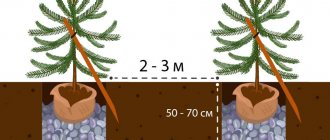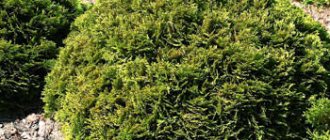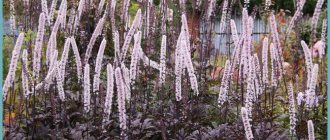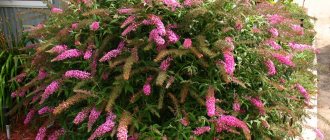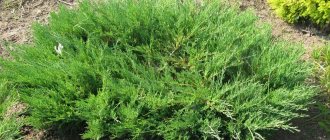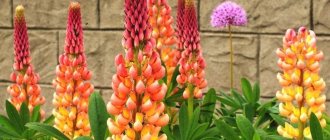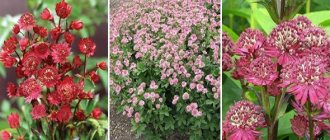From May to July, a low shrub with flowers in shades from yellow to bright orange is found in city parks. This is a representative of the buttercup family - the swimsuit (Trollius). In the European version, the name comes from the legend of forest trolls.
“Trollblumen” translated from German means “troll flower”; according to legend, this is the flower these forest inhabitants prefer to others.

In the Slavic version, the name correlates with the patroness of reservoirs, next to which this flower is often found - Agrafena Bathing Suit.
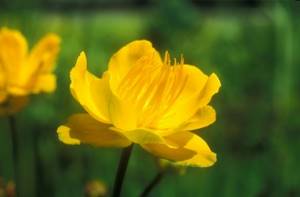
Appearance
Bathhouse is a perennial shrub, 50-100 cm high with one or several flowers on a high peduncle. The leaves of the plant are green, cut into five lobes. On one stem there are 10-25 leaves, collected in rosettes. The root system is powerful and goes deep into the ground. Several stems grow from one rhizome.
The swimsuit has gained popularity among flower growers and landscape designers thanks to its large spherical flowers. Their color varies from purple and pale yellow to bright orange.

In some varieties the flower diameter reaches 10 cm, but more often it varies between 3-7 cm. The plant is a honey plant. As you can see in the photo, the outer petals of the corolla are wide, the inner ones are narrow, transformed into nectaries and emit a faint, pleasant smell.
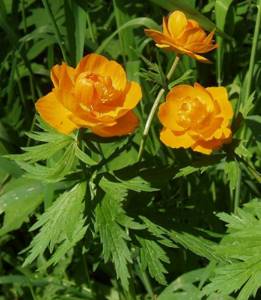
Spreading
You can meet the swimsuit both in the garden and in the wild. The cultivation of plants as ornamental plants began quite recently. In Altai, Siberia and Central Russia in spring, bright flowers can be found in meadows, clearings, and well-lit forests.
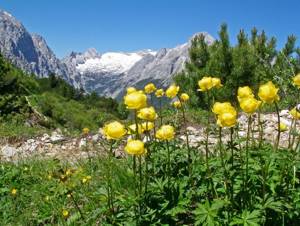
Moist, loose soil, bright sunshine and warm air are ideal conditions for this perennial. In the European part of the continent these are often mountain plants.
Planting a swimsuit in open ground
When to plant
If you are going to grow swimsuit from seeds, you should know that the seed material of this plant needs to be pre-treated at low temperatures. You can sow swimsuit seeds in late autumn in a container and keep it in an unheated room, where the seeds will undergo natural stratification during the winter months and germinate in the spring. But it is better to put the seed after harvesting in a bag with damp sand, place it in the vegetable drawer of the refrigerator and keep it there for 3-4 months at a temperature of 2-4 ºC, and in March sow the seeds in the substrate and wait for germination at a temperature of 20 ºC.
- Barberry Thunberg: cultivation, description of varieties

In the photo: Blooming swimsuit in the garden
Swimsuit seeds germinate very slowly, but by mid-April or May, seedlings will probably appear. It is imperative to protect the seedlings from direct sunlight and prevent the substrate from drying out. At the stage of development of the second true leaf, the seedlings dive, keeping a step of 8-10 cm, and in August the seedlings are planted in open ground.
How to plant
In the wild, the swimsuit grows in both sun and partial shade, but in cultivation it is advisable to grow it in well-lit places, away from the shade of trees and shrubs. The best soil for the plant is structural medium loamy or light loamy soils with a high humus content. The soil should be rich, light, and its pH should be close to neutral. The swimsuit flower can also grow on poor soils if peat mixed with humus is added to it, which will absorb moisture and retain it in the soil. Consumption of peat-humus mixture – 5 kg per m².
The seedlings, together with a lump of earth, are planted in holes located at a distance of 30-40 cm from each other. The swimsuit plant does not like transplants, and can grow in one place for 10 years. Seed-grown swimsuit blooms in the third or fourth year.
Kinds
In total, scientists have discovered and described 29 species of swimsuit, 20 of which are found in Russia. For decorative purposes, 7 varieties and a huge variety of hybrids have been bred.

The varieties obtained by crossing are aimed at obtaining a greater variety of color and plant durability. Let's look at the most common species found both in nature and in gardens.
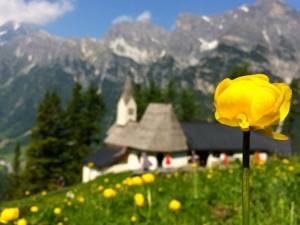
Altai bathhouse is a perennial up to 80 cm high with large yellow or orange flowers. The shape of the plant is herbaceous, the stem does not branch. Found in wet meadows of Altai, Mongolia and the northern border of China.
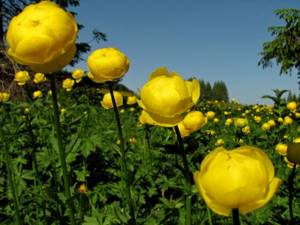
The plant can be identified by the dark, often purple color of the nectar-bearing petals in the middle of the flower. Flowering occurs from May to June.

Asian bathwort is a plant listed in the Red Book as endangered. Bright orange flowers are located on a single or branching stem reaching a height of 1 meter. The petals are double and large; the half-open flower appears in May-June.

Due to its decorative qualities, this species is often used to create hybrids. In nature, the plant is found in Western and Eastern Siberia, Altai, and Mongolia. In regions with cold climates, plant height does not exceed 10-15 cm.

European bathhouse is a herbaceous plant found in the European part of the continent and Western Siberia. In wet meadows its height reaches 1 meter, in cold tundra forests it does not exceed 20 cm.
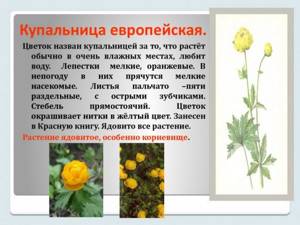
On a branched stem there are small closed flowers with colors ranging from yellow-golden to orange-golden, the middle with stamens is brighter.
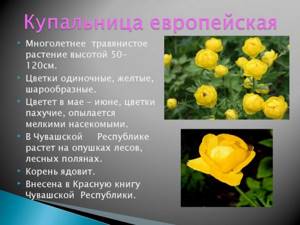
Chinese swimsuit is a species common in the Far East, China and Japan. The stems are tall - 80-100 cm, often without branching. You can recognize the plant by its bright, orange, fully open flowers with a diameter of 5-6 cm.

In the middle of the flower there are nectar-bearing petals, longer than the perianth petals. Flowering occurs later than typical representatives of this genus - in June - July.

Ledebur's swimsuit - found in wet meadows of Eastern Siberia and the Far East. The height of the stems is up to 50 cm, the flowers are large - up to 8 cm in diameter. The color of the petals ranges from pale yellow to orange, the nectaries are thin and tall. The flowers are open and can be seen in late June - early July.
Lilac bathhouse is a small plant, 10-20 cm high, with pale lilac flowers and orange nectar plants. You can find the perennial in the mountainous regions of Altai and China.
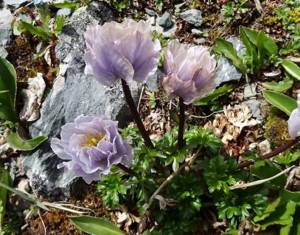
This type of swimsuit is especially sensitive to moisture; it can often be found in areas of melting glaciers and swampy areas.
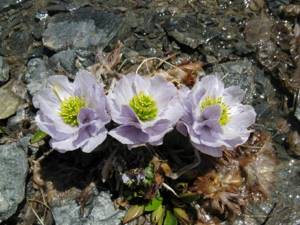
Reproduction
In nature, the swimsuit reproduces by seeds. The leaflet fruits ripen approximately a month after flowering. The seeds are small, dark, with shiny skin. In the first year after sowing, the plant just begins to form; most often there are no flowers.
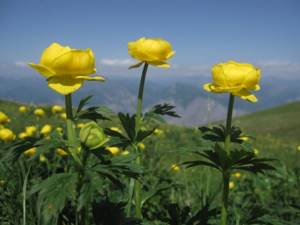
You can propagate a swimsuit in a similar way at home, but it will require a lot of effort. Seeds should be stratified in winter for 2-3 months in moist soil, planted in early spring in a greenhouse, and shoots monitored. Flowering of such plants usually occurs in 3-4 years.
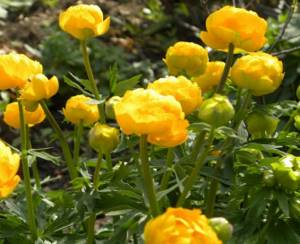
Cultivated plants are often propagated vegetatively—by parts of rhizomes or cuttings. This should be done in early spring or autumn.

When propagating by parts of the rhizome, a healthy, washed root is divided into several parts so that a shoot remains on each. The sections are treated with a manganese solution and planted.
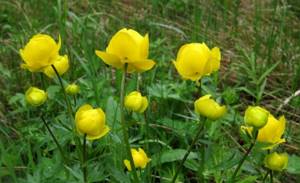
Propagation by cuttings should be carried out in the spring, before flowering begins. Ground shoots are cut and placed in water. Once the plant has taken root, it can be planted. Planting shoots of the swimsuit should be done at a distance of at least 50 cm from each other, future bushes will grow.
Growing in the garden
In order for the swimsuit to grow well and delight the eye with lush flowering, it requires regular watering, weeding and loosening of the soil. When loosening, you cannot go deeper than 3-5 cm, so as not to touch the surface roots. The soil around the bushes should be constantly mulched with peat or humus. You need to periodically add nutrient mixtures to the base of the bushes.
In the first year of life, the swimsuit has only one peduncle. Over time, their number increases. The apical flower blooms first; buds only appear on the lateral shoots during this period. To obtain secondary flowering, the bush must be cleared of faded flower stalks.
The swimsuit can grow in one place for up to 10 years, constantly growing. Periodically, the bush needs to be divided and replanted.
Choosing a location
Plants do best in sunny areas. With proper care, they can reach a height of 50-60 cm. But young bushes immediately after transplantation need protection from direct rays of the sun.
In shady places, the plant can grow up to 80-90 cm. However, it does not bloom as profusely as in open areas, and has flowers of a dull color. A bush growing in the shade develops slowly and reaches its maximum height only in the 6th year.
Watering and fertilizing
The plant requires constant and abundant watering. Especially during the hot summer period. Irrigation requires settled warm water. For this purpose, experienced flower growers place a large container of water in an open place so that it is heated by the sun. After watering, the soil around the plant must be loosened.
Fertilizing is carried out periodically along with watering. For this, urea, agricole or nitrophoska are used. The solution is prepared at the rate of 1 tsp. substances for every 10 liters of water. The best time to apply fertilizer is during bud break and the beginning of flowering.
Reproduction and transplantation
The swimsuit can be propagated by seeds. They are sown in mid-autumn. Only in May next year will shoots appear. They can be transplanted to a permanent place in the spring of the second year. The seeds of the plant are small and quickly lose their viability. They need to be sown immediately after harvest.
The swimsuit is capable of actively reproducing by self-sowing. Seedlings sprout in the spring, but they can only be replanted in early autumn. They will begin to bloom in the second year, but lush flowering will begin only in the third.
The most popular method of propagation is by dividing the clump. The process is carried out every 5 years in late summer - early autumn. Healthy, strong bushes that are at least 5-6 years old are selected for planting. By this age, the plant strengthens and gains vitality, and is able to more easily withstand the stress associated with transplantation.
The donor bush is dug up, the roots are cleared of soil and washed. Then, using a sharp knife, the bush is cut into pieces so that rosette stems with roots remain on each. The cut areas are treated with a weak solution of potassium permanganate or wood ash.
Holes for plants are prepared in advance. The distance between them should be 30-40 cm. The root collar should be deepened by 20-30 cm, having previously removed the root foliage. Young leaves grow back after 14-16 days.
Wintering
The swimsuit tolerates frost well, so it does not need additional insulation. In mid-autumn the leaves die. They are cut off, but they do it so that a small petiole remains above the surface. It will protect the bud located in the middle of the outlet. It is from this that a new flower stalk will grow in the spring.
Diseases and pests
The swimsuit is resistant to diseases and various types of pests. But improper care can cause fungal infection. As soon as the first signs of disease appear on the plant, the affected parts must be removed immediately. If the damage is significant, the bush is dug up entirely and destroyed. The soil surface and nearby plants are treated with a fungicidal solution.
Growing in the garden
Growing a swimsuit in the garden is not at all difficult. For these purposes, hybrid varieties are often chosen; they reach larger sizes compared to wild ones and have large flowers.
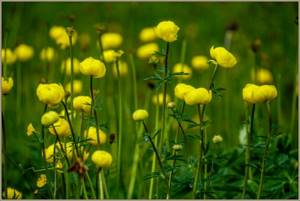
In general, this plant is unpretentious, but there are several conditions that must be observed for good flowering. Since the swimsuit loves moist soil, do not forget about watering. Acidity is not particularly important, and an additive in the form of humus or sand will be beneficial.

Shrubs can be planted both in bright sun and in moderately lit areas. The plant must be protected from weeds and pests. In one period, you can achieve a second flowering if you remove only the faded top.
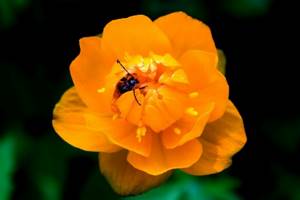
Application in landscape design
The early and bright flowering of the Asian swimmer (Trollius) “plays into the hands” of landscape designers. Along with the colorful colors of tulips, daffodils, irises, peonies, fiery spots of decorative culture will look very original.
On rocky soils, the plant thrives next to sedum, sedum and other ground cover crops.
Additionally, Asian stir-fries pair well with flowering perennials:
- lilac;
- magnolia;
- spirea;
- bells;
- host;
- bergenia.

Lushly flowering frying bushes will very beautifully complement the storyline of the shore of a small body of water

